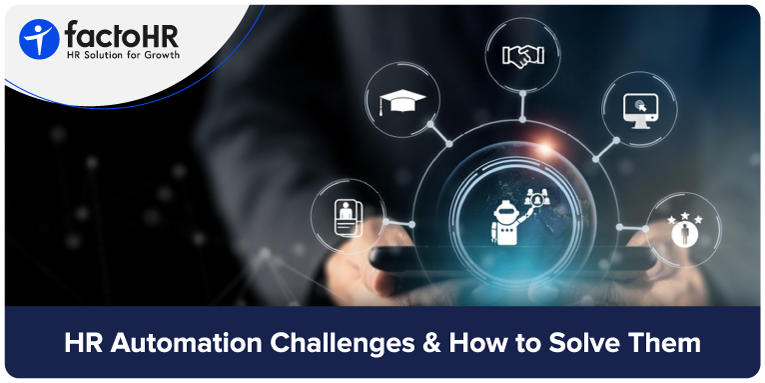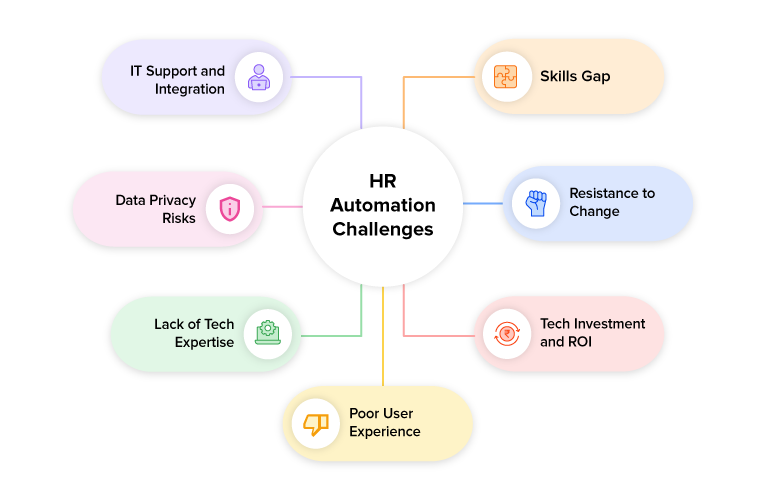Top 7 HR Automation Challenges in 2025 & How to Solve Them

Table of Contents
HR departments are constantly involved in repetitive tasks such as resume screening, onboarding, payroll management, performance management, and offboarding, which take up a lot of their time.
In today’s fast-paced world, keeping up with technology and simplifying HR processes is essential so HRs can focus on other people-centric tasks.
HR Automation replaces repetitive manual tasks with digital systems and tools, including payroll processing, leave management, and employee data tracking, handling the employee lifecycle. Streamlining workflows and increasing transparency will minimize manual errors, save time, and improve employee experiences.
Organizations can maintain consistent, accurate, and compliant HR practices by automating HR processes.
Progress may come with challenges, and HR automation also presents some real-time challenges that can be addressed. This blog will explore HR automation challenges and solutions to overcome them.

Why Addressing HR Automation Challenges is Crucial in 2025
Tackling HR automation challenges is necessary to meet increasing technological demands and transition to a centralized, accurate, and time-efficient system solution. But these benefits come with some challenges. The most common challenges that organizations face are:

- Resistance to change
- Tech Investment and ROI
- IT support and Integration
- Data Privacy & Compliance Risks
- Lack of Internal tech expertise
- Poor user experience & low adoption
- Skills Gap
Tackling HR Automation challenges helps businesses enhance their benefits and achieve a smoother implementation.
1. Resistance to Change
Resistance to change is natural among employees and management when implementing HR Automation. They may fear losing their job or hesitate to change an established workflow.
Solution:
- Communication with Employees: Listen to their concerns, get feedback on current workflows explain the purpose of automation, and demonstrate how using the new technology makes their work easier and more productive.
- Training and Support: Offer training to employees so they can effectively utilize automation tools and gain confidence in tackling HR automation challenges they encounter.
2. Tech Investment and ROI
Another challenge in HR Automation is investment and ROI. HR managers have to set a budget and present ROI for their investment. ROI can be evaluated through benefits such as cost savings and improved efficiency; however, advantages like increased employee engagement and experience are harder to quantify. HR tools that don’t deliver as expected may also raise concerns.
Solution:
- Implement Gradually: Start by automating repetitive HR tasks or essential processes, such as attendance or leave management. After implementing, gather feedback from employees. If you like it, expand gradually. Look for scalable solutions and customized pricing plans for businesses of all sizes.
- Tangible Outcomes: To check the outcome, define clear success metrics, such as reduced onboarding time, improved employee engagement, or lower operational costs, to help estimate the project’s actual ROI.
3. IT Support and Integration
A common challenge when introducing new technology is its ability to integrate smoothly with existing tools. The HR department uses multiple software systems to handle different functions. When integrating, ensure that data is consistent across all platforms and avoid the risk of data silos.
Solution:
- Flexible Solutions: Choose HR automation with reliable Application Programming Interfaces (APIs) that facilitate easy integration with existing platforms. Modern HR automation, backed by seamless HR integration, facilitates cross-functional workflows across departments.
- IT Support: Partner with vendors that offer integration services and reliable customer support for smooth workflows. Check your SLA to make sure that it covers all the requirements.
4. Data Privacy and Compliance Risks
HR departments manage confidential data, raising concerns about data privacy and security. The HR team must comply with regulations to avoid data breaches. Selecting a platform with security features like encryption, role-based access, and regulations is essential.
Solution:
- Data Privacy and Compliance: Make sure your automation software complies with data protection regulations such as the General Data Protection Regulation (GDPR) and the Health Insurance Portability and Accountability Act (HIPAA). The GDPR and HIPAA outline strict standards for handling personal information, and non-compliance can result in significant penalties.
- Data Encryption: Choose an HR automation tool that provides encryption when storing and transferring critical data. Encryption ensures that data cannot be read without the decryption key, adding an extra security layer.
- Access Control: Implement RBAC (role-based access controls) to validate that only authorized personnel can access sensitive data. RBAC allows employees to access only the information necessary for their roles, minimizing the risk of internal data breaches.
5. Lack of Internal Tech Expertise
The lack of in-house technical expertise to manage, integrate, and maintain new systems poses a challenge for HR automation. If not addressed, this can lead to HR automation issues, potential data silos, and increased costs.
Solution:
- Hiring IT professionals: Hire HR professionals with technical skills or IT specialists to successfully implement automation.
- Outsource service: Partner with IT service providers who are experts in technology & HR automation solutions.
- Invest in training: Train your existing HR professionals to improve their technical skills.
- Selecting comprehensive systems: An integrated HR management system reduces the need for an external IT professional.
6. Poor User Experience and Low Adoption
A frequent challenge in HR automation is the insufficient integration among various platforms. This requires employees to manage multiple logins and interfaces, which hinders their productivity and impacts their overall experience.
Adopting an HR automation solution depends on its success or failure. Organizations should implement a strategy to encourage employees to engage with the automation platform.
Solution:
- Implement in Phases: Introduce automation gradually. Start with HR managers, gather their feedback, and if successful, broaden the implementation. This approach allows for process refinement and higher adoption rates.
- Training: Conduct regular training sessions for employees and ensure they understand how to use the new automation solution.
7. Skills Gap
A skill gap is a difference between your employees’ skills and those required to achieve your business goals. This gap can arise as the HR team tries to adapt to automation and as job requirements evolve. Addressing the skills gap is essential for an organization to sustain competitiveness and productivity.
Solution:
- Training: Providing a thorough training to the employees so they can get used to the new technologies.
- Support: Reliable support can help employees overcome challenges while transitioning to automation.

Final Words
Shifting from pen and paper to tools that streamline HR processes is crucial to staying current with technology. Technological advancements have modernized the workflow of the HR department. Utilizing various tools for managing different HR functions may impact HR’s productivity. This technology does have some challenges. Addressing HR automation challenges to realize benefits leads to effective operations and more efficient, streamlined HR processes. Automation is not for replacing humans but to empower HRs so that they can focus on other essential tasks.
Organizations can use factoHR for a smooth transition and reliable support. The software integrates easily with your existing system and automates important and repetitive tasks. HR can easily use the interactive interface for their daily tasks.
What Causes HR Automation to Fail?
Resistance to change, poor integration with existing systems, insufficient training, failure to measure ROI, and selecting the wrong solution cause HR automation failure.
How do You Ensure HR Automation is Successful?
Focusing on strategic planning, including identifying processes for automation, selecting the right tools, integrating them with existing systems, and providing proper training for employees’ smooth adoption, ensures successful HR automation.
Which HR Functions Should be Automated First?
First, repetitive and time-consuming HR functions such as payroll, onboarding, attendance, and leave management should be automated. These functions significantly improve efficiency and accuracy. Moreover, automating tasks like leave requests and timesheet tracking can also ease processes and improve employee satisfaction.
Grow your business with factoHR today
Focus on the significant decision-making tasks, transfer all your common repetitive HR tasks to factoHR and see the things falling into their place.

© 2025 Copyright factoHR


